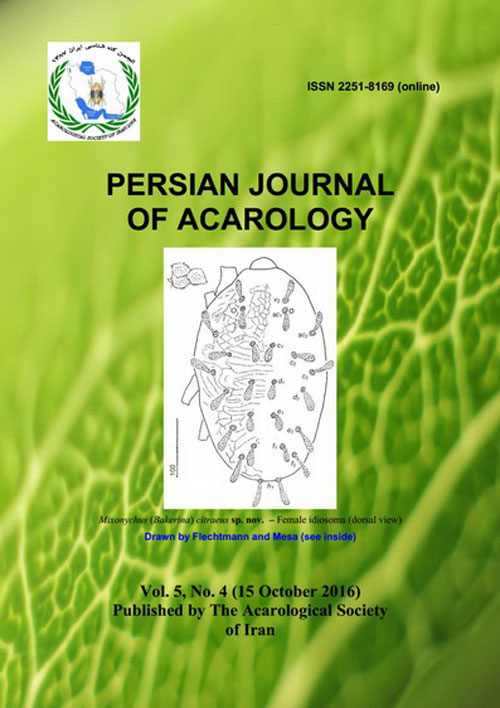فهرست مطالب

Persian Journal of Acarology
Volume:5 Issue: 4, Autumn 2016
- تاریخ انتشار: 1395/10/10
- تعداد عناوین: 9
-
-
Page 263An additional description of Oribella fujikawae Mahunka, 1982 is provided based on specimens collected from the northwest of Iran. An identification key to the known species of the genus Oribella is given.Keywords: Mite, new record, Oribella, redescription, Sarcoptiformes, taxonomy
-
Page 271A spider mite of the genus Mixonychus is reported for the first time from the Americas; a new species, Mixonychus (Bakerina) citraeus sp. nov. is described based on specimens from Citrus in Colombia. It is suggested that the new species be considered of quarantine concern for Brazil and Venezuela and, may be, other neighbouring countries of Colombia (Ecuador and Peru).Keywords: Brazil, citrus, new record, quarantine, taxonomy, Venezuela
-
Page 281A new species of the genus Stigmaeus, S. brasiliensis sp. nov. is described based on females, males and deutonymphs, collected from the São Paulo state, Brazil.Keywords: Female, predatory mites, Prostigmata, Raphignathoidea, São Paulo state
-
Page 291A new species of the genus Molothrognathus, M. shirazicus sp. nov. is described and illustrated based on the females collected from soil under desert poplar and oriental arborvitae in Shiraz, Fars province, Iran.Keywords: Bark, desert poplar, predatory mite, Shiraz, soil
-
Page 299A new pachylaelapid mite species, Pachyseius angustoides Babaeian & Mašán sp. nov., is described and illustrated, based on adult females found in leaf litter habitat in southwestern part of Iran (Chaharmahal & Bakhtiari province). The new species is morphologically compared with the most closely related congeneric species, Pachyseius angustus Hyatt, 1956, and an updated list of the world fauna of the genus is provided.Keywords: Female, Mesostigmata, Pachyseius angustoides, Parasitiformes, taxonomy
-
Page 311An annotated checklist of oribatid mite taxa from Bethuadahari Wildlife Sanctuary of West Bengal, India, is presented on the basis of a faunistic survey carried out inside the sanctuary from January, 2011 to December, 2012. A total of 44 oribatid species, belonging to 37 genera in 24 families, have been identified. The present study has also documented nine species as the new records from India. The most frequent species of this sanctuary are Protoribates (P.) magnus (Aoki, 1982), Lamellobates (L.) molecula (Berlese, 1916), Perscheloribates (P.) albialatus (Hammer, 1961), Lamellobates (Paralamellobates) bengalensis Bhaduri & Raychaudhuri, 1968, Tectocepheus velatus sarekensis Trägårdh, 1910, Multioppia radiata Hammer, 1961, and Hoplophorella cuculata (Ewing, 1909). Additionally, the most species rich families of the study area are Oppiidae Sellnick, 1937 and Scheloribatidae Grandjean, 1933.Keywords: Checklist, conservation area, forest, leaf litter, new records, soil, taxonomy
-
Page 341Lycoriella auripila Winnertz (Diptera: Sciaridae) is one of the most serious pests of mushroom cultures, Agaricus bisporus (Lange) Imbach. Damage of this pest can result in substantial yield losses directly and indirectly. Gaeolaelaps aculeifer Canestrini as a predator suppresses population of soil-dwelling pests e.g. mites, nematodes and fungi, and todays it has been considered as a commercial biological control agent against eggs and larvae of sciarid flies. Prey preference of natural enemies is one of the components of predation that should be taken into account to choose the exact releasing time against appropriate prey stages. In this study, the prey preference and predation rate of G. aculeifer were investigated at 23±1 °C, 60 ± 5% R.H. and a photoperiod of 0: 24 (L: D) h under laboratory conditions. Results showed that life stages of prey influenced prey preference, as females of G. aculeifer killed 5.66 ± 0.33 and 2.33 ± 0.21 of 2nd and 3rd instar larvae of L. auripila respectively. Accordingly, Manly's index of preference was 0.697 ± 0.0377 and 0.303 ± 0.0377, respectively. This difference might be attributed to prey size difference between 2nd (1.36 ± 0.08 mm) and 3rd (2.52 ± 0.10mm) sciarid larval instars. Moreover, In terms of obtained results, proper timing of releasing predatory mite reduces sciarid fly population efficiently. It has been recommended that releasing of G. aculeifer females prior to emergence of 3rd instar larvae of L. auripila would suppress the sciarid flies population densities in mushroom production.Keywords: Agaricus bisporus, biocontrol, Manly's index, predation rate, sciarid fly

